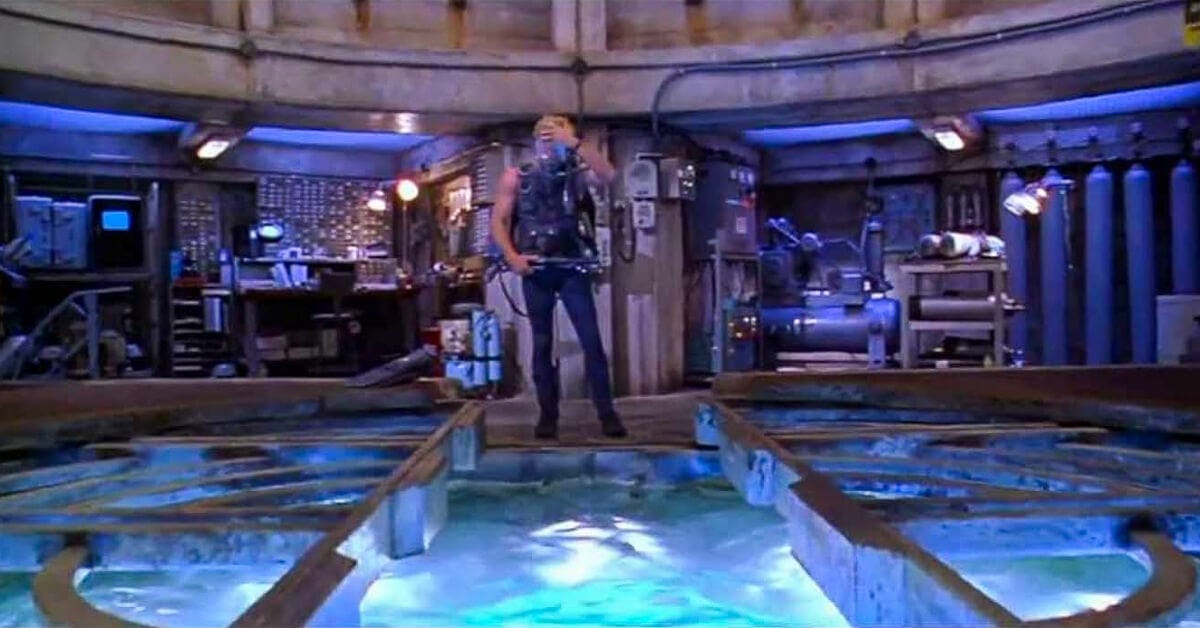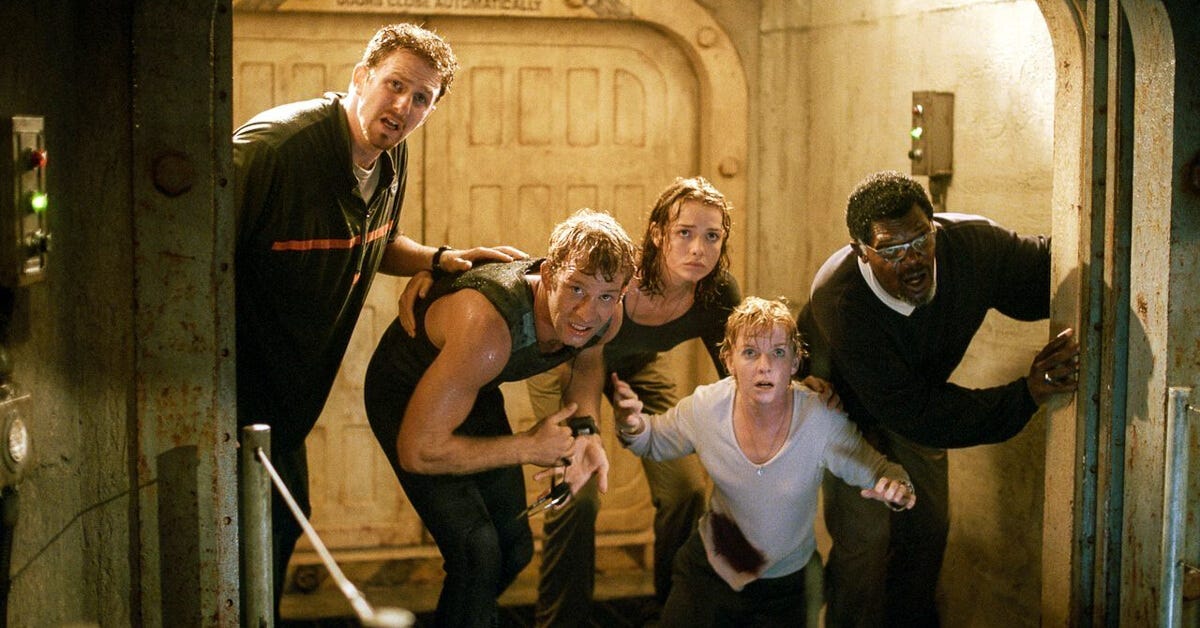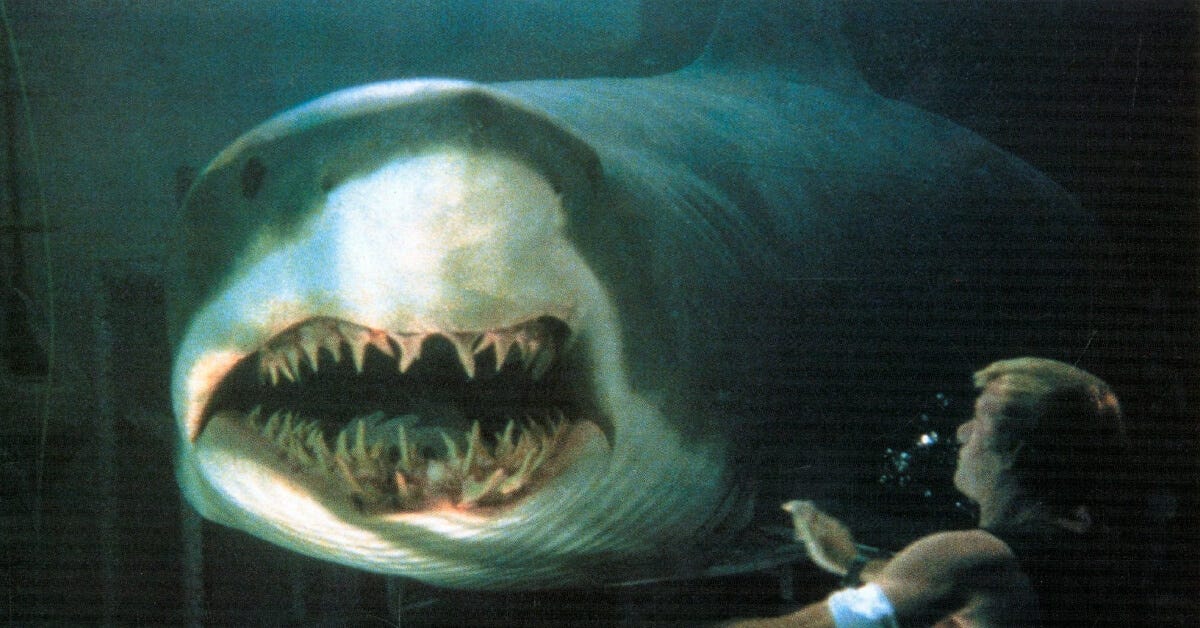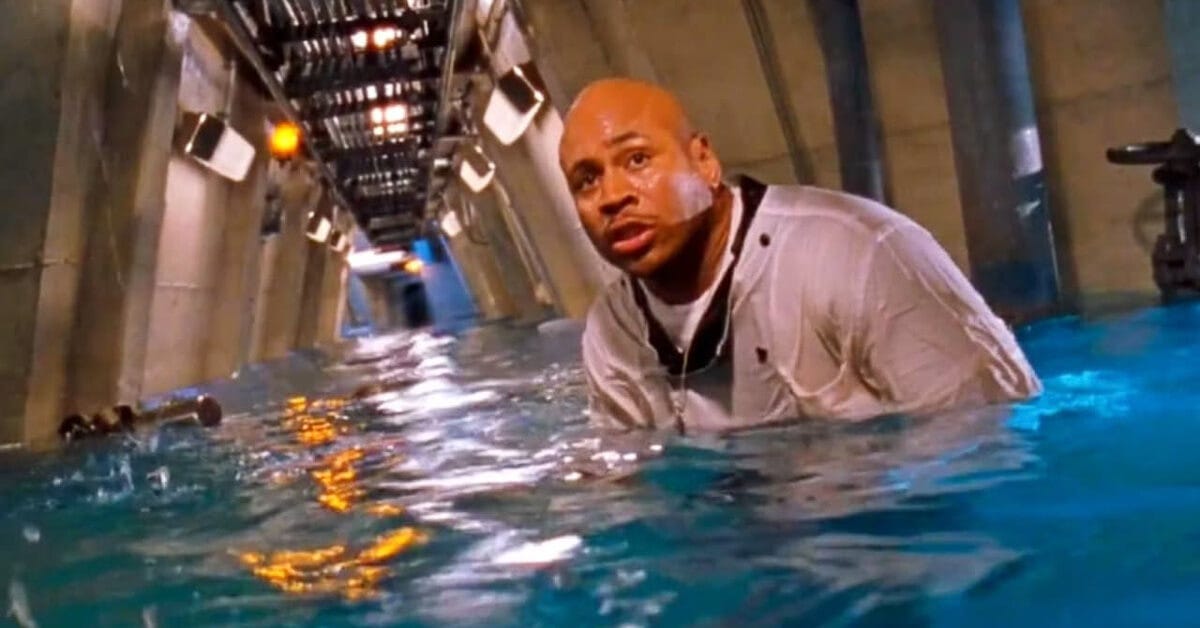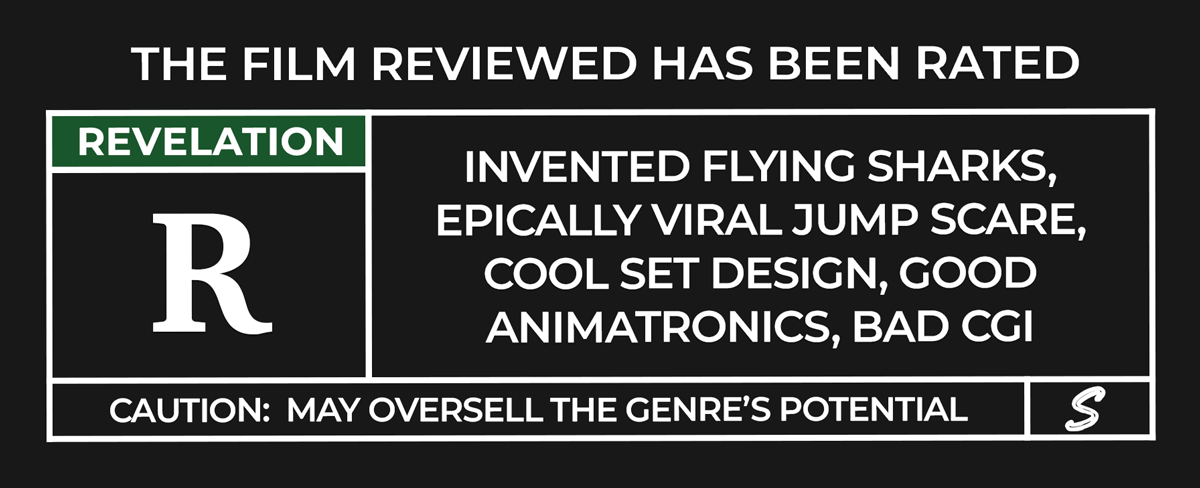Deep Blue Sea: Still the Best Shark Movie That Isn’t Jaws
Judgment: REVELATION · Cinema DEFCON: 4
🎧 [PLAYBACK: SOUND ON]
Cue up Trevor Rabin’s playful orchestral swells for your read. A fun little aside about one of its punchier beats following the review…
🟢 For the full stream, open the score on Spotify instead.
"That's impossible! Sharks do *not* swim backward... They can't!"
Gee, ya think?
They also can’t roar like lions, either.
Jaws: The Revenge already pulled that stunt — and we all know how that turned out.
Jaws for the Blockbuster Age
A dozen years after the now-half-century-old OG shark franchise took its final, flailing bow, hilariously sending a clairvoyant great white to stalk Mrs. Brody on a Bahamian vacay, Die Hard 2 director Renny Harlin dove back into open water with a pulpy, gory thrill-ride only the ‘90s could birth.
And SINephile contends that, 26 years later, Deep Blue Sea still ranks as the second-best shark film ever made.
Now, Harlin’s preparing to dip a toe back into chum-filled waters with his long-delayed Deep Water, starring Aaron Eckhart and Sir Ben Kingsley (Gandhi), in which a trans-Pacific plane crash lands survivors squarely in voracious shark territory. Whether Harlin still has his sea legs or he’s drumming up another Cutthroat Island remains to be seen, but either way, we’re totally on board to judge the fallout.
Ironically, famed '80s/’90s erotic thriller auteur Adrian Lyne also returned from a long hiatus with his own Deep Water in 2022, a tepid Ben Affleck / Ana de Armas genre reboot attempt that fizzled on landing.
Everyone seems to want to go deep these days. Not all survive the dive.
Smarter Sharks, Dumber Science
By today’s standards, the setup of Deep Blue Sea is so boilerplate it’s practically lab-grown:
A skeleton crew of scientists at an isolated underwater lab called Aquatica are developing an Alzheimer's drug using genetically modified tiger sharks as test subjects.
When a tropical storm hits during a weekend visit from their primary investor, the power fails, the facility floods, catches fire, AND explodes. Because it’s Renny Harlin, so of course it does.
Expectedly, the sharks break free — both from the physical confines of their caged pens and with more brainpower than every human in the cast combined (except maybe, LL).
None of the shark science holds any water, obviously. But that’s half the fun. Deep Blue Sea plants its tongue so firmly in cheek it’s flirting with lockjaw.
It knows exactly what it is — and it’s here to bring the receipts.

Chew or Be Chewed
The picture’s impressive, gloriously eclectic cast commits with unapologetic self-awareness:
Samuel L. Jackson delivering a monologue like he’s keynoting a TED Talk
Thomas Jane, as the stoic, brooding shark whisperer with a hidden past
Michael Rapaport, the overly talkative tech nerd
Stellan Skarsgård, whose epic early demise is easily the film’s grisliest
Saffron Burrows, icily pretending she’s not the villain
And LL Cool J, as the chef who steals the whole damn movie, giving not just the “Lovely Ladies” a reason to adore him
The practical shark animatronics, shot in Jim Cameron’s custom-built Titanic tanks off Baha, Mexico, repurposed just two years after that shoot, still impress today. While the thankfully rare, yet entirely jarring, CGI shark inserts? Not so much.
But let’s be honest: we didn’t come for realism.
We came to watch sharks do the impossible. And they don’t disappoint.
Deep dive for free with SINephile — weekly film analysis, sharper takes, and original scores you didn’t know you needed.
The Shark's Real Villain?
Despite Jaws’ rightful place among the best of the horror canon (with its deserved spot on the SINephile 100), this entire waterlogged sub-genre has done undeniable damage to sharks’ public image over the past half-century.
What should be seen as a vital apex predator — essential to not just marine ecosystems, but our entire ecological chain both above and below the surface — is far too often reduced to a mindless monster.
For decades, pop culture has repeatedly fed that myth in pursuit of the almighty dollar, and shark populations have sadly paid the price.
I had my first real encounter with sharks — three tiger sharks off the Kona coast, to be exact — during my advanced scuba training 15 years ago. It was love at first sight.
Graceful, wary, mesmerizing. Nothing like the rabid killing machines portrayed onscreen. At least from 90 feet below.
Are there risks? Sure, they’re wild animals. But as long as you know the rules of engagement, the risks are both calculated and negligible.
I’ve since traveled the world to dive with and observe almost every major shark species in their natural habitat in every ocean, save the Arctic (because, brrr…). And I’ve done so with an increasing sense of urgency.
Sharks have survived five mass extinction events. They’ve outlived dinosaurs, outlasted ice ages, and stayed virtually unchanged for over 400 million years, making them one of Earth’s oldest animals (a fact that Stellan Skarsgård is here to remind you about in the film).
But they’re not likely to survive us.
Fear for Profit, Extinction as Collateral
Pre-Jaws, global shark populations were relatively stable, and the threat from human activity was minimal.
Today, we kill over 100 million sharks each year.
More than one-third of all subspecies are now threatened with extinction. Some of the most demonized on-screen — including hammerheads, makos, and great whites — are likely to disappear within a generation. Ironically, the monsters we fear most are the ones disappearing the fastest.
On average, all shark species combined kill 5-6 of us worldwide annually — nearly every incident is a case of mistaken identity from humans on the surface looking and acting a little too much like their primary food source. Almost never underwater, where they can actually see you.
Spielberg himself has repeatedly expressed regret for the unintentional ecological fallout from the success of Jaws and the entire sub-genre he invented. Still a phenomenal film — it just means there’s nuance. And in today’s discourse, nuance is viewed as enemy.
For a gut-punch of a documentary on the subject, SINephile highly recommends Eli Roth’s Fin, simply put, the best film he’s ever made (trigger warning: it's brutal).
But credit where it’s due: Deep Blue Sea at least has the decency to make its sharks genetically modified. They’re not villains. They’re science experiments gone wrong.
And that earns the movie just a few extra bonus points on the SINemeter.
If you ever felt the need to see water ballet performed to rap music, LL’s here to serve in the classic shark-themed music video of the movie theme song.
DEEP CUTS:
+ 1 point for the license plate nod to Jaws
- 1 point for cutting all of Ronny Cox’s dialogue as the Big Pharma CEO (we get one silent close-up of Captain Bogomil... seriously?)
+ 3 points for changing the ending after test audiences rightfully agreed that the wrong character survived.
+ 10 points for LL Cool J and his wise-ass talking parrot simply named “Bird”
Shark movies rarely pass even the most rudimentary of science quizzes — but it’s almost never this much fun to watch them fail.
SINemeter Judgment: REVELATION
📊 [PLAYBACK: RECEPTION]
Production Budget: $60M (~$112M adjusted)
U.S. Theatrical Release: 1,854 theaters
Key Competition: Runaway Bride, The Sixth Sense, The Blair Witch Project & The Thomas Crown Affair
Opening Weekend: $18.6M (~$36M today)
Opening Rank: #3
Worldwide Box Office: $165M (~$290M today)
Cinema DEFCON Threat Assessment: DEFCON 4
Theatrical-to-DVD Window:
4.5 months (Jul 28 - Dec 7, 1999)
Verdict:
Released wide on a Wednesday — rare for the time — likely to beat the weekend competition and capitalize on early word-of-mouth.
The moderate theatrical-to-DVD delay was standard summer blockbuster strategy: milk the box office, then stoke anticipation for the home release.
This lands Deep Blue Sea at DEFCON 4, the level ironically already labeled, “We’re Gonna Need a Bigger Boat.”
🧠 [PLAYBACK: FUN FACTS]
Just when you thought it couldn’t get any campier: six years after Deep Blue Sea’s release, one of composer Trevor Rabin’s pulsing film score cues — originally used during the doomed helicopter rescue — was recycled by long-running TV reality series The Biggest Loser to overhype the drama of contestant weigh-in reveals.
Take a listen →
From tiger sharks to treadmill tears... now that’s range, people.
🎬 [PLAYBACK: TRAILER]
Well, here’s a throwback…
Send them this review. Then stage an intervention. Share it, sound off in the comments about your favorite non-Jaws sharksploitation, or just toss us a like — no blood in the water, we promise.



